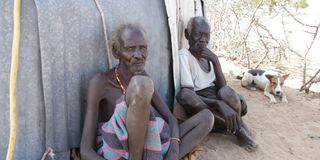Thousands facing acute hunger as drought bites in Marsabit

Hunger stricken residents of Illeret village in Marsabit county earlier this year.
More than 55,000 households in Marsabit County are staring at a disaster due to the ongoing drought in northern Kenya.
Humanitarian agencies have warned that there is a looming crisis in the drought-stricken regions such as Laisamis and North Horr sub-counties should no immediate interventions be taken.
While speaking to the Nation during a food distribution to more than 4000 households in the Laisamis sub-county, a Canadian-based Christian World Service (CWS) Project coordinator Mike Kendagor explained that the situation was not desirable in the region.
“There is need for increased effort, longer-term and more complex interventions to eliminate the threat of starvation and prevent famine entirely, including processes to strengthen education, nutrition, livelihood resilience, and social protection systems,” Mr Kendagor said.
"The ongoing drought poses a big threat to the education sector and regional health. The children under five were the hardest hit. The situation could turn into the worst humanitarian crisis in the century if not well managed," Mr Kendgor said.
He urged the government and other humanitarian agencies to focus more on relief operations in the affected regions to avert the looming loss of human lives.
He said Acute Food Insecurity classifications have indicated that Northern Kenya was approaching a catastrophic phase.
Marsabit county has not received rains for over three years and over 1 million livestock have been lost to drought thus exposing the residents to food insecurity.
The dire food insecurity situation has also been exacerbated by inter-tribal conflicts since 2019.
CWS relief food programme has benefited 8,000 households in the drought-stricken Laisamis and North Horr sub-counties .
Laisamis Assistant County Commissioner Charles Mbole expressed fear that the gains made in bringing education closer to children from pastoralist families in northern Kenya could be eroded by the ongoing drought.
School attendance has resulted in dropouts as learners move to far-flung areas in search of pasture alongside their parents.
Some learners were also too weak to walk to school due to starvation.
“The number of people in need has increased more than what was projected three months ago since nearly every house is affected in this area. The national government and other partners are also at the forefront of the relief food operations. There are cash transfer programmes as well as provision of livestock pellets,” Mr Mbole said.
Namarei Chief Andrew Limaru observed that at least 60 percent of learners in three schools had dropped out before the two-weeks break.
He said the most affected are Lengima Primary School with about 60 percent dropout rate, Lekuchula Primary School with 45 percent, and Namarei Primary School with 30 percent.
"Learners who often trek for over 10 kilometres to school are the most affected. The situation is dire for vulnerable groups such as children under five years, elderly persons, expectant and lactating mothers, and people with disabilities," the chief said.
Similar sentiments were echoed by Korr Location Senior Chief Jeremiah Intimo who said several learners in five schools were affected.
"There is a need for immediate assistance in nutrition and health. Most families only survived one meal a day as the drought continued to bite," Ms Julieta Sumpe, a resident of Laisamis said.
Kureya Galmugle, a mother of five from the Orletitikes area in Korr Location told the Nation that her three children often relied on school-feeding programmes to survive.
However, the school feeding programmes were also faced with crises due to the inconsistency of the food supplies by the humanitarian agencies.
Water provision was also a major setback to learning in the area as most of the boreholes had dried up in the region.
Ltalisona Kurima who lived with disabilities lamented that they were faced with a massive crisis as they were now living off relief food supplies.
“Without immediate emergency food assistance, we face starvation. We also need more instant cash injection help to reel them back from the precipice of the imminent famine facing this region,” Mr Kurima said.
According to the World Food Programme (WFP), at least 13,000 nursing women and children under five years old were put under nutrition-resilience programs.
In May 2022, Doctors Without Borders, reported that malnutrition in Marsabit had hit a ‘level three’ crisis phase.





